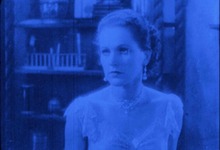"Cornell’s first and most impressive film, ROSE HOBART (c. 1936), illustrates many of the ideas he later expressed about Hedy Lamar and Jennifer Jones. The film is essentially a reediting of EAST OF BORNEO, a 1931 jungle drama from Universal Pictures, with Rose Hobart and Charles Bickford. Apparently Cornell thought that George Melford’s talking picture contained ‘passages to remind one … of the suggestive power of the silent film to evoke an ideal world of beauty.’ (…)
For the most part, Cornell has isolated […] transitional moments [of the film] and reorganized them in his montage. He included nothing of the final volcanic destruction and almost nothing of the lengthy and perilous voyage upriver to Marudu, which opens the original film. Yes his montage is startlingly original. Nothing like it occurs in the history of the cinema until thirty years later. The deliberate mismatching of shots, the reduction of conversations to images of the actress without corresponding countershafts of her interlocutor, and the sudden shifts o location were so daring in 1936 that even the most sophisticated viewers tended to see the film as inept rather than brilliant. Yet Cornell carried this roughness several steps further. He incorporated some continuous passages from the original film — sequences containing as many as eight shots in a row — which serve to remind us of the obligatory fluidity of Hollywood editing during that period. They make Cornell’s reconstruction look all the cruder. His retention of a connective shot here and there (say, the corresponding figure in a conversation with the heroine) underlines his eccentric ellipses. Finally, he displays a fondness for using some shots just as they were fading out or just as a door was closing, omitting the main action." - P. Adams Sitney
1 PRINT IN DISTRIBUTION
|
distribution format |
Digital file on server (FHD) |
|
notes
|
Blue version |
|
screen |
16/9 (single screen) |
|
speed |
24 fps |
|
sound |
sound |
|
rental fee |
85,00 € |




